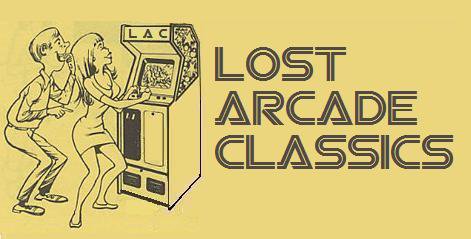

As an ‘80s kid, I always looked forward to grocery shopping day, despite the fact that my parents typically shopped at the one grocery store (Giant Food) that didn’t have arcade games, unlike their retail contemporaries Safeway, A&P, or Thriftway.
But since Giant didn’t have games to play, I instead camped out in front of the magazine rack, and reviewed the pages of Joystik, Electronic Fun with Computers and Games, and of course, the groundbreaking Electronic Games. As my parents shopped, I immersed myself in pictures and text, learning everything I could about the current video game scene. I often had an entire magazine nearly read before my folks would check out and buy it anyway. By the way, isn’t this truly a snapshot of a simpler time? I can’t imagine any parent in today’s day and age letting their ten-year-old sit unattended at a magazine rack while they shopped, especially considering the mammoth size of today’s stores. But not once was I hassled by shopper or employee, and indeed, I was left alone to peacefully read about games that never appeared in my neck of the woods like Subroc 3-D, Domino Man, Arabian, Star Rider, and Pop Flamer.
One of these “not anywhere near me” games was featured in the pages of the January 1984 issue of Video Games Magazine. Despite my lack of interest in sports, this particular sports-themed game intrigued me, and the opponents’ names’ of “Clee and the Ords” stuck with me for years after reading the article. That game, and this issue’s Lost Arcade Classic, is Eastern Micro Electronics’ Hoccer.
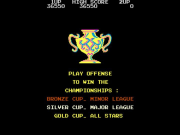 Hoccer, who’s marquee displays the subtitle “Body Check Hockey", is a futuristic interpretation of the game of ice hockey. The player controls Andrew, a one-man team playing against the aforementioned Clee and the Ords, a group of homicidal hockey-loving cyborgs. No word on whether they are Canadian, however.
Hoccer, who’s marquee displays the subtitle “Body Check Hockey", is a futuristic interpretation of the game of ice hockey. The player controls Andrew, a one-man team playing against the aforementioned Clee and the Ords, a group of homicidal hockey-loving cyborgs. No word on whether they are Canadian, however.
After pressing the start button, the player chooses to face off against opponents in the minor league, major league, or on the all-star team. The skill level selected dictates the speed and number of opponents Andrew faces, along with the point values gained for completing objectives. (The point values I’ll be referencing today are taken from the “minor league” skill level). A bird’s eye view of a hockey rink with goals at each end, and star-targets along the sides is then displayed. Andrew enters from the southern end of the rink, and the player uses a four-way joystick and an action button to help him eliminate opponents, score goals, rack up points, and hopefully advance into the finals.
Even though the game is based on hockey, the objective is actually to eliminate the Ords, and scoring goals is secondary. The number of opponents left to smash is symbolized by a string of dots that appear in the upper right. Eliminate an Ord, and a dot disappears. After 30 seconds or so, any undefeated Ords exit the rink, causing a loss of scoring potential, although Andrew will still advance to the next screen.
The preferred way of dealing with Ords is shooting the puck directly at them. Depending upon the number of Ords hit per shot, Andrew gets 500, 1,000, or 1,500 points. If Andrew doesn’t have possession of the puck, he can still shove Ords against the rink wall for 500 points each. Shooting the puck, or shoving an Ord, is done by facing the opponent and pressing the action button.
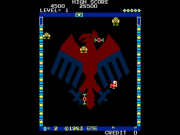 Clee, the Ord’s team Captain, is a tougher model of cyborg with a special unique ability. Shooting the puck at Clee allows him to take possession, and in his capable robotic hands, the puck becomes a deadly weapon. When Clee launches the puck, it speeds up, leaving a comet-like trail behind it, and it’s “time out” for Andrew if he gets hit. So the solution is simply to never shoot the puck at Clee, right? Wrong! Once Andrew shoots the puck anywhere, Clee can intercept it. Accept the inevitable. Clee WILL fire the puck at you.
Andrew's best defense is to remain alert, and dodge abruptly when Clee fires. Once the puck eventually comes to rest on the ice again, it’s safe for Andrew to grab it. Luckily, Clee’s lowlier teammates cannot grab and shoot the puck. Clee himself can usually only be eliminated by smashing him against a wall like the other Ords, but on the rare instance that the “comet puck” ricochets and hits Clee after he has fired it, then Clee is the one turned to dust.
Lest your opponents become too aggressive, Andrew can “chill them out” by scoring a goal. Doing so awards the player 1,000 points, and all opponents freeze (actually, they hop up and down in place, which is rather amusing), giving Andrew the opportunity to smash them into the walls. The goal slides back and forth rapidly to the accompaniment of a high pitched alarm, then after a few seconds, it spits the puck back out in a random place, and any non-smashed Ords start moving again.
Clee, the Ord’s team Captain, is a tougher model of cyborg with a special unique ability. Shooting the puck at Clee allows him to take possession, and in his capable robotic hands, the puck becomes a deadly weapon. When Clee launches the puck, it speeds up, leaving a comet-like trail behind it, and it’s “time out” for Andrew if he gets hit. So the solution is simply to never shoot the puck at Clee, right? Wrong! Once Andrew shoots the puck anywhere, Clee can intercept it. Accept the inevitable. Clee WILL fire the puck at you.
Andrew's best defense is to remain alert, and dodge abruptly when Clee fires. Once the puck eventually comes to rest on the ice again, it’s safe for Andrew to grab it. Luckily, Clee’s lowlier teammates cannot grab and shoot the puck. Clee himself can usually only be eliminated by smashing him against a wall like the other Ords, but on the rare instance that the “comet puck” ricochets and hits Clee after he has fired it, then Clee is the one turned to dust.
Lest your opponents become too aggressive, Andrew can “chill them out” by scoring a goal. Doing so awards the player 1,000 points, and all opponents freeze (actually, they hop up and down in place, which is rather amusing), giving Andrew the opportunity to smash them into the walls. The goal slides back and forth rapidly to the accompaniment of a high pitched alarm, then after a few seconds, it spits the puck back out in a random place, and any non-smashed Ords start moving again.
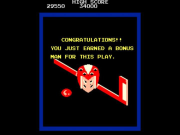 The ice rink also sports various spinners about its surface. Shooting a puck through a spinner causes the star blocks to flash, and knocking out those flashing stars with your puck adds 200, 400, 600, 800, and 1,000 points for the fifth and any consecutive block. Any non-flashing stars knocked out during normal play awards only 100 points each. Clearing all the stars awards an extra life.
The ice rink also sports various spinners about its surface. Shooting a puck through a spinner causes the star blocks to flash, and knocking out those flashing stars with your puck adds 200, 400, 600, 800, and 1,000 points for the fifth and any consecutive block. Any non-flashing stars knocked out during normal play awards only 100 points each. Clearing all the stars awards an extra life.
Clee and the Ords can be smashed against the spinners, but the same fate can befall Andrew if he is caught between a spinner and a well-timed shove from a cyborg opponent.
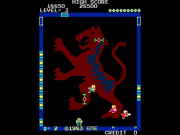 Each level is played in six rounds… the first and second halves of the quarterfinals, in which he faces the “Hawks”, then the “Lions” are met in the two games of the semifinals, and the level concludes with the two halves of the championship game, against “The Dragon”. Even though the teams have different names and logos, rest assured they are the same Ords, always led by Captain Clee.
Each level is played in six rounds… the first and second halves of the quarterfinals, in which he faces the “Hawks”, then the “Lions” are met in the two games of the semifinals, and the level concludes with the two halves of the championship game, against “The Dragon”. Even though the teams have different names and logos, rest assured they are the same Ords, always led by Captain Clee.
Destroying all the cyborg opponents in the second half of the championship game awards a bronze, silver, or gold trophy, along with corresponding bonus points, upon which Andrew advances to the next difficulty level and fights his way through another six rounds for the next trophy.
Hoccer’s graphics are average for ‘83, as Andrew and his opponents are depicted as squat little humanoid sprites similar to characters like Dig Dug and Mario, but with greater limb animation. There’s not a lot of detail on the playfield, although the rink is adorned with large team logos. The Hawks logo resembles a classic Native American design, and the logos for the Tigers, and The Dragon are portrayed in a “Ye Old English” style, by way of early ‘80s computer graphics of course.
Sound effects consist of several cute jingles and a simple background tune, and a nice “shoosh-shoosh” skating sound. The puck produces various blips and beeps when it hits anything, and there is an appropriate muffled explosion sound when an Ord or Clee bites the dust.
To date, I’ve never played an actual Hoccer machine. After reading the Video Games article, I kept my eyes peeled, hoping that each time I entered some newly discovered arcade or street location, I would see a Hoccer nestled among the Pole Position II and Elevator Action machines. But alas, it was not meant to be. I began to suspect that Hoccer was never released at all, and perhaps it was a prototype title that hadn’t been green lighted for production.
My first confirmation that the game truly existed was via MAME about 10 years ago, which ended over fifteen years of curiosity.
 Since then, I’ve only seen pictures of one dedicated Hoccer machine, (provided here courtesy of Stephen R. Warner, thanks Steve!), and one unused complete conversion kit, which was listed on Ebay years ago. Once in a great while, the marquee shows up for sale, but it’s certainly not what you would call a common game by any stretch of the imagination.
Since then, I’ve only seen pictures of one dedicated Hoccer machine, (provided here courtesy of Stephen R. Warner, thanks Steve!), and one unused complete conversion kit, which was listed on Ebay years ago. Once in a great while, the marquee shows up for sale, but it’s certainly not what you would call a common game by any stretch of the imagination.
In addition to Hoccer, Eastern Micro Electronics (which was based out of Somerset, New Jersey) also released Changes (a Pac-Man styled maze chase), Dinosaurs (an early entry into the “uncover the picture” genre), Triple Crown (a video card game), Alien War (there’s almost no information about this one out there, I’m assuming it’s a slide and shoot typical of the era), and they also were granted a license to produce Universal’s Mr.Do! for a time.
A sales flyer exists showing that EME also sold several generic cabinets of the upright, cabaret, and cocktail table varieties, designed for easy conversion kit installation. However, these exact same cabinets (among several additional styles) were also featured on a flyer from Artic / ATW Inc. of Taiwan. It appears that Artic / ATW may have licensed their most popular cabinet designs to New Jersey’s EME for reproduction or marketing purposes. The EME flyer doesn’t mention Artic / ATW however, so the exact relationship between the two companies is unclear.
Now, as a quick side detour… wayyyyyy back in 1993, in the early days of the world wide web, I contributed some brief game descriptions to the “Coin-Ops-A-Poppin'” list, which was the precursor to the current Killer List of Video Games, a.k.a. KLOV.
In addition to contributing blurbs about Free Kick, Asteroids Deluxe, Space Gun, and many others, I described Hoccer as featuring “pinball game inspired characters”. I was referring, of course, to the spinners and star targets, which reminded me of the spinners and drop targets in a pinball game. A few months later, I saw the next revision of the list, and a comment had been placed after my Hoccer description.
“Anyone know just what ‘pinball game inspired characters’ is supposed to mean?”
I never got around to replying to the question. And eventually it became a moot point, as KLOV supplanted the Coin-Ops-A-Poppin’ list in 1995 with all new text for each game entry.
But upon reviewing that original 1984 Video Games Magazine article, I see a passage that reads as follows:
“There are spinners (shades of pinball?) on the ice…”
Well, it appears that I subconsciously borrowed the idea of using a pinball reference from that original VGM article. And why is George Harrison’s “My Sweet Lord” floating through my head all of a sudden? Anyway, I humbly apologize to any fellow classic gaming enthusiasts that may have been confused by my original Hoccer description on the Coin-Ops-A-Poppin’ list lo’ those many moons ago.
So grab a tall frosty one and prepare to root for Andrew, the one man team, as he battles his cyborg nemeses. Feel the spray of ice in your face as an Ord changes direction suddenly, and experience the thrill of combat as Andrew and Clee attempt to smash each other up against the wall… all from the comfort of your rink side seat in the EME stadium annex of the Museum of the Lost Arcade Classic.